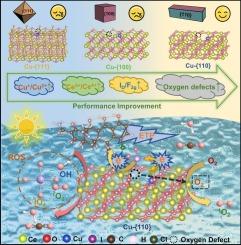太阳光照下CeO2通过配位环境调制高效活化高碘酸盐:面间协同作用和cu物种修饰。
IF 9.7
1区 化学
Q1 CHEMISTRY, PHYSICAL
引用次数: 0
摘要
氧化铈(CeO2)是一种稀土金属氧化物,在日光介导的高碘酸盐(PI)活化中显示出潜在的废水处理潜力,尽管其应用受到活性位点和光吸收的限制。本文采用面形工程和异金属原子取代的方法来控制CeO2的配位环境,以提高其催化活性。分别制备了优势暴露{100}、{110}和{111}面的Cu修饰CeO2。Cu物种对切面的修饰提高了CeO2对抗生素废水的降解效率,降解效率为Cu-{110} (99.28%) > Cu-{100} (95.80%) > Cu-{111}(89.24%)。在阳光介导的PI活化中,Cu-{110}对污染物降解具有广泛的pH适应性,对阴离子和水基质具有良好的抗抑制作用,并且具有长期的催化稳定性。Cu-{110}处理后的TC废水生物毒性得到完全去除和深度净化。表征和理论计算表明,面形工程和Cu物种修饰耦合策略调节了CeO2表面的配位环境,诱导PI在低配位态≡氧缺陷附近的Ce(III)原子的吸附和络合,从而加速自由基•OH、IO4•-和非自由基1O2的生成以及电子转移过程。此外,配位环境的调节扩大了CeO2对太阳光的吸收范围,提高了光生载体的分离度,实现了活性位点的连续再生。本研究开发了一种高效的阳光介导PI活化催化剂,并为调节金属氧化物催化剂的配位环境以提高其在废水净化中的活性提供了新的见解。本文章由计算机程序翻译,如有差异,请以英文原文为准。

High-efficiency periodate activation by CeO2 under solar light via coordination environment modulation: Synergy between facets and cu species modification
Cerium oxide (CeO2) is a rare earth metal oxide that shows potential for wastewater treatment in sunlight-mediated periodate (PI) activation, although its application of CeO2 is restricted by limited active sites and light absorption. In this work, facet engineering and heterometallic atom substitution were used to manipulate the coordination environment of CeO2 to boost its catalytic activity. Cu species-modified CeO2 with dominant exposed {100}, {110}, and {111} facets were prepared, respectively. The modification of facets by Cu species improved the degradation efficiency of CeO2 for antibiotic wastewater, and the degradation efficiency was Cu-{110} (99.28 %) > Cu-{100} (95.80 %) > Cu-{111} (89.24 %). In the sunlight-mediated PI activation, Cu-{110} exhibits a wide pH adaptability range for pollutant degradation, excellent anti-inhibition to anions and water matrices, and long-term catalytic stability. The biological toxicity of TC wastewater treated with Cu-{110} was completely removed and deeply purified. Characterization and theoretical calculations revealed that the facet engineering and Cu species modification coupling strategy regulated the coordination environment of the CeO2 surface, induced the adsorption and complexation of PI in the low-coordinated state ≡Ce(III) atoms adjacent to oxygen defects, and thus accelerated the generation of radicals •OH, IO4•− and non-radical 1O2, as well as the electron transfer process. Besides, the regulation of the coordination environment expanded the absorption range of CeO2 for sunlight and elevated the separation of photogenerated carriers, achieving continuous regeneration of active sites. This work develops an efficient catalyst for sunlight-mediated PI activation and provides new insights into modulation of the coordination environment of metal oxide catalysts to boost their activity in wastewater purification.
求助全文
通过发布文献求助,成功后即可免费获取论文全文。
去求助
来源期刊
CiteScore
16.10
自引率
7.10%
发文量
2568
审稿时长
2 months
期刊介绍:
The Journal of Colloid and Interface Science publishes original research findings on the fundamental principles of colloid and interface science, as well as innovative applications in various fields. The criteria for publication include impact, quality, novelty, and originality.
Emphasis:
The journal emphasizes fundamental scientific innovation within the following categories:
A.Colloidal Materials and Nanomaterials
B.Soft Colloidal and Self-Assembly Systems
C.Adsorption, Catalysis, and Electrochemistry
D.Interfacial Processes, Capillarity, and Wetting
E.Biomaterials and Nanomedicine
F.Energy Conversion and Storage, and Environmental Technologies

 求助内容:
求助内容: 应助结果提醒方式:
应助结果提醒方式:


